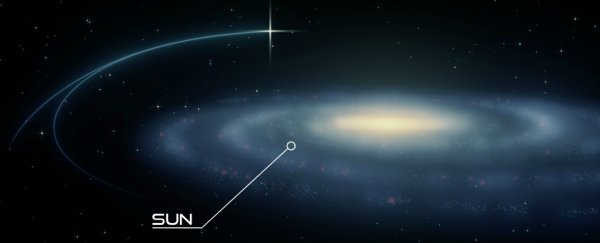You don't need a Stephen Hawking-level of understanding to know that things usually orbit other things in the Universe, but apparently nobody told that to PB 3877 - a binary star system that's traveling 2 million kilometres per hour (1.24 million mph) away from the Milky Way.
Yup, PB 3877 is trying to strike out on its own despite the gravitational pull of our galaxy, and researchers have no idea why. Even crazier, at such speeds, the binary system may actually reach galactic escape velocity, which would send it into intergalactic space.
According to a team of astrophysicists from the University of Erlangen-Nuremberg in Germany, our current understanding of physics cannot explain why PB 3877 is moving in such a manner.
Normally, when a star system acts like this, it's because it recently passed the Milky Way's supermassive black hole, which - thanks to its insane amounts of gravity - basically slingshots things far out of the galaxy, Christopher Crockett explains for Science News. But this is not the case with PB 3877.
So what the heck is going on?
Well, there aren't many proposed answers yet, but the team thinks that the strange behaviour could stem from the Milky Way colliding with a smaller galaxy.
This would mean that there are other stars currently moving in odd directions, too. Besides that, a supernova (or exploding star) would have the potential to push PB 3877 off into the outskirts of the galaxy, though this is unlikely, because it would have probably destroyed the binary system in the process, Crockett points out.
"From our calculations, we can exclude the galactic centre as the place of origin because its trajectory never came close to it," said team member Eva Ziegerer in a press release. "Other ejection mechanisms, such as stellar collisions and a supernova explosion, have been proposed, but all of them would lead to the disruption of a wide binary."
With little else to go on, the team will continue their research, which was done using spectroscopic observations from the Keck II telescope in Hawaii. Hopefully, with further study, we will eventually figure out the answer. Until then, your guess is as good as theirs.
The team's findings were published in Astrophysical Journal Letters.
